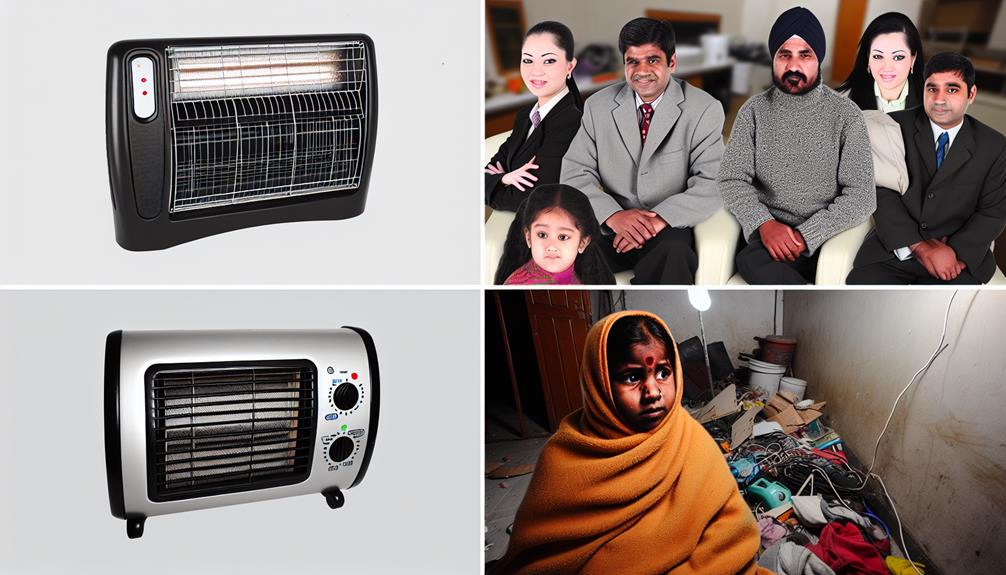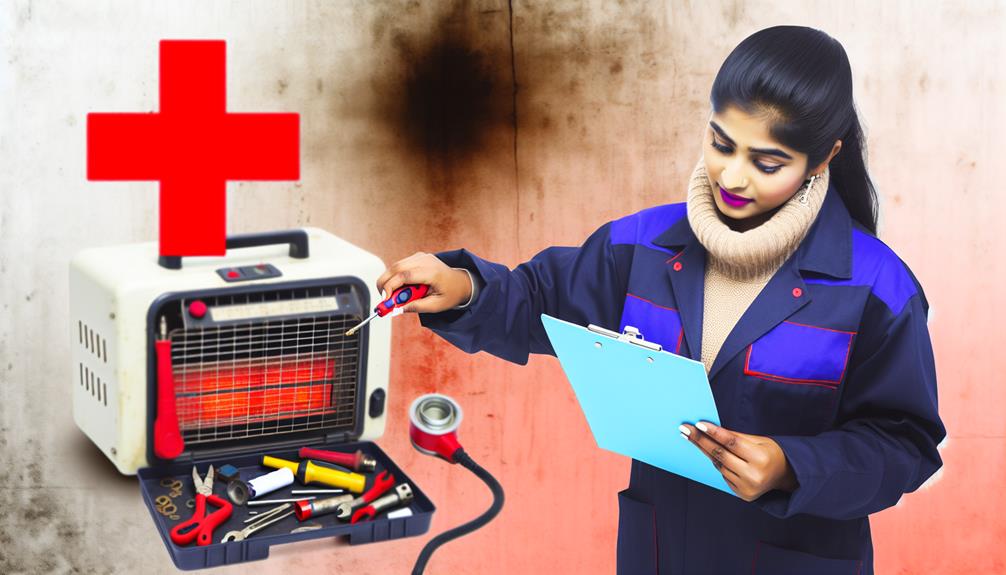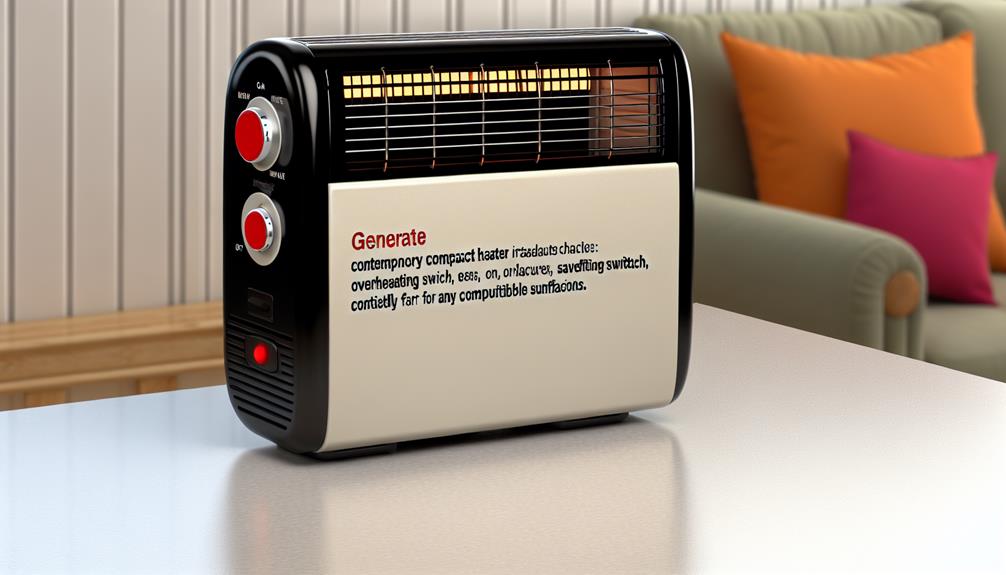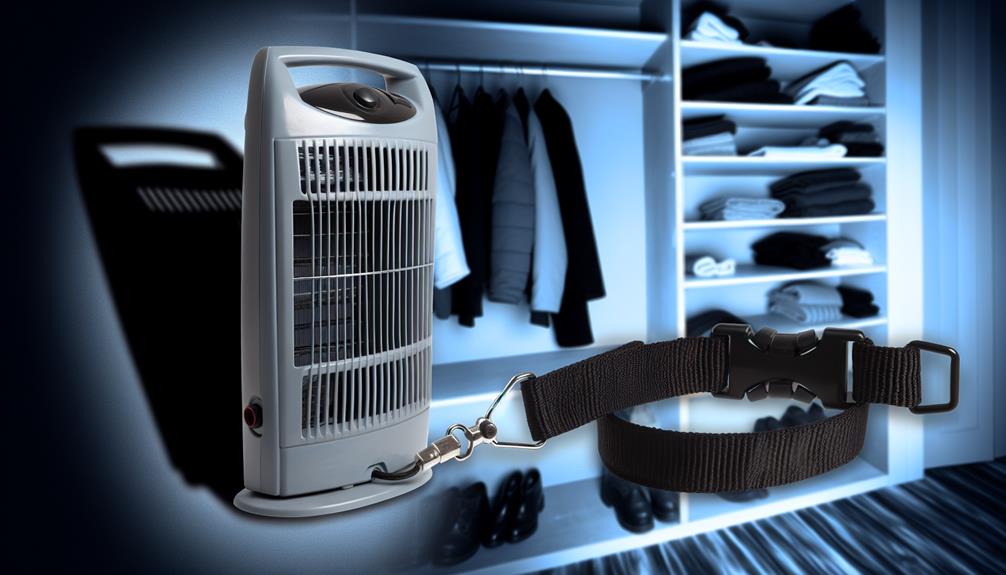Is it truly possible to stay cozy and safe with a portable heater humming softly in your room? You've likely heard myriad tips on how to operate these convenient devices, but separating fact from fiction is crucial when your safety is at stake. As you rely on this compact source of warmth during chilly days, bear in mind that the difference between comfort and hazard often lies in the details of usage and maintenance. You'll want to be well-versed in the essential do's and don'ts—from selecting the right heater to positioning it correctly, and from conducting regular checks to understanding its features. Let's explore the critical guidelines that ensure your portable heater serves as a bastion of warmth, without compromising on safety or efficiency. And as you consider these points, ponder this: what simple, often overlooked actions could be the key to preventing a fire hazard in your home?
Key Takeaways
- Choose a heater with safety certifications and features such as automatic shut-off and cool-to-touch surfaces
- Place the heater at a safe distance from combustible materials and on a stable surface
- Regularly inspect and maintain the heater, including cleaning filters and checking for unusual noises or smells
- Follow safe usage practices such as proper ventilation, keeping the heater out of reach of children, and avoiding enclosed spaces for fuel storage.
Choosing the Right Heater

When selecting a portable heater, it's crucial to consider the type, size, and safety features that best fit your space to prevent potential hazards. Your choice should hinge on a balance between heating capacity and energy efficiency. A heater's capacity, usually measured in watts, indicates its power and effectiveness to raise the temperature in a given area. You'll want to opt for a unit with a heating capacity proportional to the size of your space to ensure it's neither overworking nor underperforming.
It's not enough to just pick a heater with the right capacity; you also need to verify its safety certifications. Look for labels from recognized testing organizations, such as Underwriters Laboratories (UL) or Intertek (ETL), which signify that the heater has met stringent safety standards. These certifications assure that the heater has undergone rigorous testing for potential hazards like overheating and electrical malfunctions.
You must be mindful of the various types of heaters available—convection heaters are generally suitable for heating entire rooms, whereas radiant heaters target specific areas or objects. Each comes with distinct safety features, such as automatic shut-off if tipped over or overheated, and cool-to-touch surfaces, which are essential if you have children or pets.
Proper Placement Guidelines
When setting up your portable heater, it's crucial to maintain a safe distance of at least three feet from all combustible materials. Ensure the heater is placed on a stable, level surface to prevent any accidental tipping. Always adhere to these guidelines to significantly reduce the risk of fire hazards in your home.
Safe Distance Parameters
Ensuring your portable heater is positioned at least three feet away from any flammable materials, such as curtains, bedding, and furniture, is critical for maintaining a safe environment. This clearance space is not just a recommendation; it's a vital precaution to prevent fire hazards that can escalate quickly, endangering your home and loved ones.
- Keep Loved Ones Safe: Avoid the heartache of accidents by maintaining a safe zone around your heater.
- Protect Your Belongings: Cherished personal items can be lost in an instant to a fire; safeguard them with distance.
- Preserve Your Peace of Mind: Sleep soundly knowing you've taken proactive steps to prevent fires.
- Avoid Costly Mistakes: Home repairs can be financially devastating; a simple measure can prevent unnecessary expenses.
Stable Surface Essentials
Your portable heater's stability is non-negotiable; always place it on a flat, level surface to mitigate the risk of tipping and potential fires. Surface material matters, too. Opt for non-flammable, sturdy materials that can support the heater's weight without warping. Carpets, rugs, or uneven ground are unsuitable as they can cause instability or overheating.
Ensure level footing by checking the surface with a spirit level if necessary. A wobbly heater is a hazard. If your heater has legs or a base, they must all make firm contact with the ground to avoid any rocking motions. Remember, a stable heater not only prevents accidents but also ensures efficient operation. Don't compromise on this crucial aspect of heater safety.
Regular Maintenance Checks

Regular maintenance checks are crucial for the safe operation of any portable heater, as they help prevent potential hazards and ensure optimal performance. Neglecting these checks can lead to a shortened heater lifespan and may even void your warranty coverage. It's important to remember that your portable heater works hard to keep you warm, and just like any other appliance, it needs your attention to keep running smoothly.
To keep your portable heater in top condition, make sure you:
- Inspect the power cord regularly: Look out for any signs of wear, fraying, or damage. A compromised cord can be a fire hazard, tugging at your peace of mind every time you turn the heater on.
- Clean the filters and air intake grills: Dust and debris can build up and impede airflow, not only reducing efficiency but also potentially becoming a fire risk. Imagine the relief of breathing in clean, warm air without worry.
- Check for any unusual noises or smells: These could be telltale signs of internal issues that, if left unaddressed, could turn your cozy haven into a no-go zone.
- Review the manufacturer's guidelines: Stick to a regular maintenance schedule and follow any specific recommendations to ensure your heater's safety and longevity. Feel the satisfaction of knowing you're upholding the standards that keep your warmth worry-free.
Safe Usage Practices
While maintaining your portable heater is essential for its longevity, adopting safe usage practices is just as critical to prevent accidents and ensure your comfort remains hazard-free. First and foremost, you must recognize the importance of ventilation when using your heater. Without proper airflow, carbon monoxide, a colorless, odorless gas that can be deadly, may accumulate. Ensure that the room is well-ventilated, particularly if you're using a gas-powered unit. Open a window slightly or use an exhaust fan to promote air exchange.
Furthermore, be vigilant with childproofing strategies when heaters are in use. Keep the heater out of reach of children and do not allow them to operate it. Consider using a safety gate around the heater if it's necessary to have it in a space where children play or spend time. Additionally, never leave a portable heater unattended when children are present. This proactive approach is crucial in preventing burns or other injuries.
Always place your heater on a level, stable surface where it won't be knocked over. Keep it at least three feet away from anything flammable, such as curtains, furniture, or bedding. It's also important to plug the heater directly into a wall outlet rather than using an extension cord, which can overheat and potentially cause a fire.
Lastly, turn off your portable heater before leaving the room or going to bed. Regularly check the heater for any signs of damage or wear, and never use a damaged heater. By following these detailed, preventative measures, you'll not only protect yourself and your loved ones but also extend the life of your portable heater.
Understanding Heater Features

How does understanding your heater's features contribute to safety and efficiency? Well, when you're familiar with the specific attributes of your portable heater, you're not only ensuring a warm and cozy environment but also safeguarding your home and loved ones from potential hazards. Heater types vary widely—from convection and radiant heaters to oil-filled and ceramic models—each with their own operating mechanisms and safety features. Recognizing these differences is crucial.
Temperature control is a key feature you'll want to master. It allows you to customize the warmth of your space without overheating or wasting energy. But that's just the start. Here's a bullet list encapsulating the essentials:
- Automatic shut-off: A lifesaver in case the unit tips over or overheats.
- Cool-touch exterior: Keeps curious little fingers and paws from getting burned.
- Timer functions: Lets you fall asleep without worrying about running the heater all night long.
- Overheat protection: Prevents the unit from becoming a fire hazard by shutting down if internal components reach unsafe temperatures.
These features are not just about comfort; they're about peace of mind. You'll sleep better knowing you've taken the necessary precautions to prevent accidents. As you shop for a portable heater or assess the one you already own, don't just look at the price tag or wattage. Dive into the manual, understand the ins and outs of your device, and remember that the more you know, the safer you'll be. It's about taking control of your warmth without compromising on safety. So, get to know your heater, and enjoy the warmth responsibly.
Energy Efficiency Tips
To ensure your portable heater operates at peak efficiency, you must strategically position it away from drafts and in a space where heat can circulate properly. Conducting regular maintenance checks, including inspecting for dust accumulation and verifying the integrity of electrical connections, is critical for both safety and energy conservation. Neglecting these steps not only risks your safety but also leads to increased energy consumption and higher utility bills.
Optimize Heater Placement
Positioning your portable heater correctly can significantly boost its efficiency and ensure you're getting the most out of your energy expenditure. Heater orientation and ventilation importance cannot be overstated. By following these guidelines, you'll not only save on bills but also contribute to a safer, more comfortable environment.
- Place it away from foot traffic: Avoid accidental bumps or tip-overs that can lead to disasters.
- Ensure proper clearance: Keep it at least three feet from combustibles to prevent fires.
- Direct the heat sensibly: Aim it towards the living space, not towards curtains or furniture.
- Maintain ventilation: Even in the coziest setup, good air circulation is essential to avoid fume buildup.
Adhere to these points and you'll find peace of mind in the warmth of your efficiently placed heater.
Regular Maintenance Checks
While proper heater placement is a critical step for safety and efficiency, it's equally important to regularly perform maintenance checks to ensure your heater runs optimally and avoids energy waste. Filter cleaning and wiring inspection are vital to maintaining your heater's efficiency and preventing potential hazards.
Here's a quick maintenance checklist:
| Maintenance Task | Frequency | Notes |
|---|---|---|
| Filter cleaning | Monthly or as required | Prevents airflow blockage |
| Wiring inspection | Annually | Identifies wear or damage |
| General inspection | Each use | Checks for visible defects |
| Professional servicing | As per manufacturer | Ensures thorough maintenance |
Don't underestimate the importance of these tasks. Regular maintenance not only extends the life of your heater but also ensures it functions safely and efficiently, keeping those energy bills in check.
Handling and Storage Solutions

Ensuring your portable heater's longevity and safety, proper handling and storage solutions are vital components to consider. When it comes to fuel storage, you must be meticulous; improper handling could lead to hazardous leaks or spills. Always store fuel in a cool, dry place, away from living areas and out of reach of children. For electric heaters, cord management is essential to prevent tripping hazards and protect the cords from damage. Make sure to gently coil the cord and avoid placing furniture on it or running it under a carpet where it can overheat.
Here are some key points to ensure you're handling and storing your portable heater the right way:
- Inspect the Heater Before Storing: Look for any signs of wear or damage. A faulty heater can be a fire risk, even when it's not in use.
- Choose a Dry, Ventilated Area for Storage: Keep the heater away from moisture that could cause rust or electrical issues.
- Keep It Out of Reach: Store the heater high up or in a locked area to prevent children or pets from accidentally turning it on.
- Avoid Enclosed Spaces for Fuel Storage: Store fuels in a well-ventilated area to reduce the risk of fumes accumulating and creating a fire hazard.
Emergency Preparedness Steps
In the face of potential emergencies, it's essential you're armed with a clear action plan for your portable heater to mitigate risks and ensure a swift response. Power outages can occur with little warning, and it's your responsibility to understand how your portable heater will function during these times. If your heater relies on electricity, consider investing in a battery-powered or fuel-based alternative that can be safely used. Keep an ample supply of appropriate fuel stored in a secure, ventilated area, adhering strictly to the manufacturer's guidelines to prevent accidents.
You must familiarize yourself with the signs of malfunctioning equipment, such as unusual smells or sounds, and know how to shut off your heater quickly. In the event of a heater-related fire, you should have a fire extinguisher readily accessible and know how to use it. It's also critical to ensure that smoke and carbon monoxide detectors are installed and functioning properly in areas where heaters are used.
Your evacuation plans should explicitly include scenarios where your portable heater may be involved in an emergency. Identify multiple exits from each room and establish a meeting point outside your home. Practice evacuation drills regularly with all household members, emphasizing the importance of leaving personal belongings behind and exiting quickly and safely.
Lastly, always keep a list of emergency contact numbers, including the local fire department and poison control center, in a readily accessible location. By taking these proactive steps, you're not only safeguarding your home and loved ones but also ensuring that you're prepared to handle any situation that may arise with your portable heater.
Frequently Asked Questions
Can I Use a Portable Heater if the Plug or Cord Shows Signs of Wear or Damage?
Would you risk a fire for a bit of warmth? Absolutely not. If your heater's plug or cord is damaged, do not use it. Frayed wires and worn insulation are serious fire hazards, demanding immediate attention. Don't attempt cord repair yourself unless you're qualified; it's not worth the danger. Prevent accidents by having a professional fix it or replace the heater altogether. Safety must always come first.
Are There Any Health Risks Associated With Using Portable Heaters for Prolonged Periods?
Yes, using portable heaters for extended periods can pose health risks. You need to be aware that they can degrade indoor air quality and, if not properly vented, emit carbon monoxide, a dangerous, odorless gas. To prevent these risks, ensure your space is well-ventilated and your heater is in good working order. Be vigilant about maintenance to avoid harmful exposure and keep yourself safe.
How Should I Safely Dispose of an Old or Non-Functioning Portable Heater?
To safely dispose of an old or non-functioning portable heater, you'll need to find local recycling programs that accept electronic waste. Ensure you're not tossing it in the trash, as it contains materials that could be harmful to the environment. If it's still working but you don't need it, consider donation options—many organizations welcome working appliances. Always follow your municipality's guidelines for electronic waste to prevent potential hazards.
Is It Safe to Use a Portable Heater in a Bathroom or Other High-Humidity Areas?
You're playing with fire if you're not careful about using portable heaters in high-humidity areas like bathrooms. Ensure the heater has water resistance and a safety certification for such environments. It's crucial to follow the manufacturer's guidelines to the letter and never leave the heater unattended. Prevention is better than cure, so always prioritize these measures to protect yourself and your home from potential hazards.
Can I Leave a Portable Heater Running Overnight While I Sleep?
You shouldn't leave a portable heater running overnight while you sleep. There are significant overnight risks, including potential fire hazards. Fire safety is paramount, and these devices can overheat, tip over, or malfunction. Always prioritize preventative measures: turn off the heater before bed, ensure it's on a stable surface, and never cover it. An unattended heater poses a serious risk; it's better to find alternative ways to stay warm.
